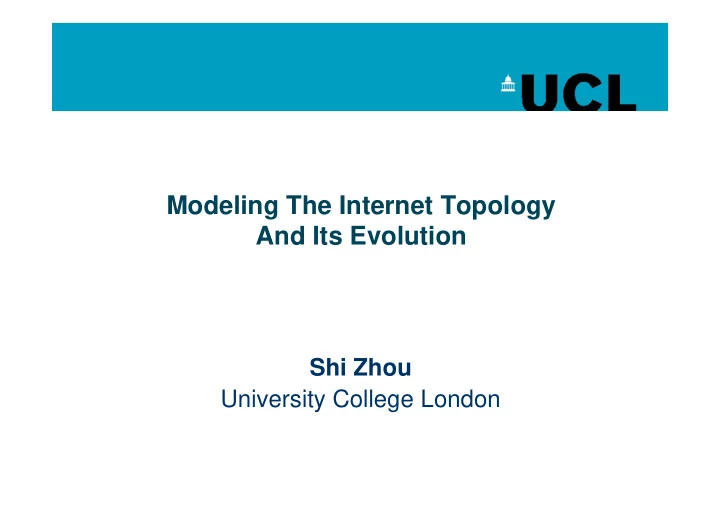

Modeling The Internet Topology And Its Evolution Shi Zhou University College London
Outline • Part 1. Background • Part 2. The PFP model • Part 3. Evaluation of the PFP model • Part 4. Discussion 2
Part 1. Background • Why study Internet topology? – Because structure fundamentally affects Router-level graph, Lumeta function. • This work focuses on the Internet topology at the autonomous systems (AS) level. – 100M hosts, 2M routers and 10K ASes in 2002. AS-level graph, CAIDA 3
The Internet AS-level topology • Scale-free network – Power-law degree distribution • Small-world network – Average shortest path length is 3.12 hops. • Disassortative mixing – Negative degree-degree correlation • Rich-club phenomenon – ‘Rich’ node are tightly interconnected as a core. 4
What is a good model? • Accurate • Complete – A full picture, a large set of topology properties. • Simple • Evolving – Using generative mechanisms. • Realistic 5
Part 2. The PFP model • The Positive-Feedback Preference model – Physical Review E, vol.70, no.066108, Dec. 2004 • Two mechanisms – Interactive Growth – Positive-Feedback Preference 6
` The Barabasi-Albert (BA) model • Growth of new nodes. P(k) ~k -3 • Linear preferential attachment 7
Observations on Internet historic data (1) • The internet evolution is largely due to two processes – Attachment of new nodes to the existing system. – Addition of new internal links between old nodes. • Majority of new nodes are each attached to no more than two old nodes. • Ratio of links to nodes is approximately three. So, independent growth of new nodes and new links? 8
Mechanism 1 -- Interactive Growth With probability p With probability 1-p • Intuition: new customer triggers a service provider to develop new connections to other service providers. 9
Observations on Internet historic data (2) • The maximum degree is very large. – As large as one fifth of the total number of nodes. • Link-acquiring ability – Low-degree nodes follow the BA model's linear preference. – But high-degree nodes have a stronger preference. ��� k So, exponential preference ? 10
Mechanism 2 – ‘ Positive-Feedback ’ Preference “Rich not only get richer, but get disproportionately richer.” 11
Part 3. Validation of the PFP model • ITDK0403 , Traceroute measurement of the Internet AS graph collected by the CAIDA’s active probing tool Skitter in April 2003 – 9204 nodes and 28959 links • CN05 , Chinese Internet AS graph in May 2005. – 84 nodes and 211 links • Same model parameters – Interactive growth, p=0.4 – PFP, δ =0.021 CN05 12
Degree Distribution γ K max CN05 -2.21 38 PFP -2.21 39 ITDK -2.254 2070 PFP -2.255 1950 13
Rich-Club Phenomenon 14
Rich-Club Connectivity Club membership: The richest r nodes • or nodes with degree larger than k. • Ratio of actual links to maximum possible links between club members. θ n clique CN05 -1.42 3 PFP -1.42 3 ITDK -1.48 16 PFP -1.48 16 15
Papers on the rich-club phenomenon • Shi Zhou and Raul J. Mondragon, 'The rich-club phenomenon in the Internet topology', IEEE Communications Letters, vol. 8, no. 3, pp.180-182, March 2004. • Shi Zhou and Raul J. Mondragon, , 'The missing links in the BGP-based AS connectivity maps (extended abstract)', in Proc. of Passive and Active Measurement Workshop (NLANR-PAM03), San Diego, USA, April 2003. 16
Disassortative Mixing Assortative coefficient (1 � α ���� α CN05 -0.328 PFP -0.298 ITDK -0.236 PFP -0.234 17
Shortest Path Length ��������� l* CN05 2.54 PFP 2.54 ITDK 3.12 PFP 3.07 18
Triangle Coefficient 19
Part 4. Discussion • A precise and complete Internet AS topology generator? • Structure of CN05 is consistent with ITDK0304. – Implication: The Internet evolution is driven by universal performance-orientated technical issues. • Limitation of the PFP model – A phenomenological model, need more analysis. 20
Thank You ! s.zhou@ucl.ac.uk 21
Recommend
More recommend